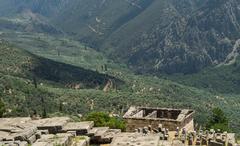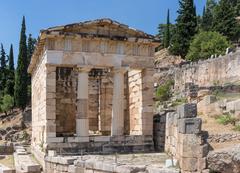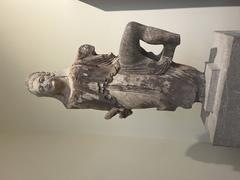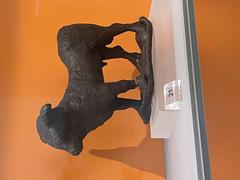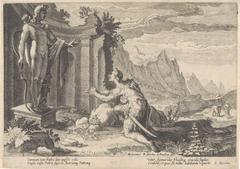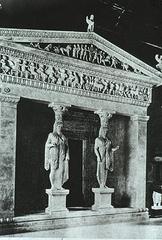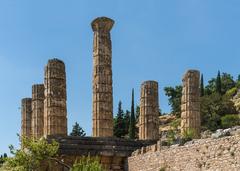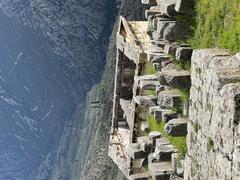
Athenian Treasury Delphi Greece: Visiting Hours, Tickets, and Historical Sites Guide
Date: 14/06/2025
Introduction to the Athenian Treasury at Delphi
Nestled within the Sanctuary of Apollo at Delphi, the Athenian Treasury is a striking testament to ancient Greece’s religious devotion, civic pride, and artistic achievement. Built shortly after Athens’ pivotal victory at the Battle of Marathon (circa 490 BCE), this monument served both as a repository for votive offerings to Apollo and as a powerful symbol of Athenian identity and influence. Crafted from luminous Parian marble in the Doric order, the treasury’s metopes vividly depict the heroic labors of Herakles and Theseus, narrating themes of virtue, strength, and civic excellence.
Strategically positioned along the Sacred Way, the main processional path to the Temple of Apollo, the treasury commanded the attention of pilgrims and dignitaries alike, reinforcing Athens’ place at the heart of Panhellenic affairs. Today, it is one of the best-preserved monuments at Delphi, offering visitors a window into the religious, political, and artistic life of classical Greece.
This guide provides an in-depth look at the Athenian Treasury’s history, architecture, and cultural significance, alongside essential information for visiting Delphi: current opening hours, ticket options, accessibility, and tips for making the most of your experience (delphi.culture.gr; Evendo; curioustravelbug.com).
Table of Contents
- Introduction
- Origins and Construction
- Purpose and Function
- Architectural and Artistic Features
- Religious and Political Significance
- Visiting Hours, Tickets, and Facilities
- Navigating the Site
- Delphi Archaeological Museum Overview
- FAQs
- Conclusion
- References
Origins and Construction
The Athenian Treasury was constructed between 510 and 480 BCE, with most evidence suggesting completion shortly after Athens’ victory at Marathon (delphi.culture.gr; Wikipedia). Built entirely of Parian marble, it set a new standard for treasury buildings and measured approximately 6.57 by 9.65 meters. Its position on the Sacred Way ensured maximum visibility, replacing an earlier structure and cementing Athens’ long-standing ties to Delphi (traveladdicts.net).
Purpose and Function in Ancient Greek Society
The primary role of the Athenian Treasury was to store dedications—ranging from spoils of war to lavish offerings—made by Athenians in gratitude to Apollo. These treasures commemorated triumphs, especially the defeat of the Persians at Marathon, and signaled Athens’ prosperity and divine favor (delphi.culture.gr; greeka.com). Treasuries were also political statements: by erecting a prominent, ornate structure, Athens asserted its power and sought to inspire both reverence and rivalry among other Greek city-states (delphi.tours).
Architectural and Artistic Features
Design and Materials
The Athenian Treasury is a distyle in antis structure—featuring two columns framed by projecting side walls (antae) at the entrance. It was the first treasury at Delphi built entirely of marble, including a distinctive red-painted marble roof (delphi.culture.gr). The stepped podium at its base bears a dedicatory inscription linking its construction to the spoils of Marathon (Pleiades).
Sculptural Program
The treasury’s metopes—rectangular panels above the architrave—are its artistic highlight. Originally numbering thirty, the metopes were adorned with two mythological cycles: the Labors of Herakles (panhellenic hero) and the Exploits of Theseus (Athenian founder-hero). This deliberate juxtaposition underscored both shared Greek values and Athens’ unique identity (von den Hoff, 2009, p. 101). The sculptures, in the late Archaic style and originally brightly painted, are now displayed in the Delphi Archaeological Museum.
Inscriptions and Decoration
The walls of the treasury were inscribed with honorary decrees and hymns to Apollo, providing insights into Athenian customs and their relationship with Delphi (delphi.tours). The acroteria—sculptures on the roof’s corners—depicted Amazons, reinforcing themes of struggle and victory.
Religious and Political Significance
Delphi was considered the omphalos (navel) of the ancient world—a place where mortals could commune with the divine (realgreekexperiences.com). The Athenian Treasury’s prominent location and lavish design functioned as both an offering to Apollo and a declaration of Athens’ military and civic ascendancy. Its dedication after Marathon celebrated not only divine favor but also Athens’ new position as a leader among Greek city-states (travelthegreekway.com).
Visiting the Athenian Treasury: Hours, Tickets, and Facilities
Opening Hours
- Summer (April 1 – October 31): 08:00–20:00 (last admission 19:40)
- Winter (November 1 – March 31): 08:30–15:30 (last admission 15:10)
Check the official Delphi Archaeological Museum site for current hours, especially during holidays or special events.
Tickets
- Standard Admission: €12 (2025 rate) for adults
- Reduced Admission: €6 for children (ages 6–25 from non-EU countries), seniors, and eligible groups (with valid proof)
- Free Admission: Children under 5, EU citizens under 25, and students (with appropriate ID)
- Special Free Days: First Sunday of the month (November–March) and select holidays (Entrance Fee).
Tickets cover entry to both the archaeological site—including the treasury—and the museum (Athens Cabs).
Accessibility
The site is on a hillside with uneven, sometimes slippery stone paths. Visitors with mobility challenges may require assistance, as there are no ramps or elevators (curioustravelbug.com).
Facilities
- Restrooms: Located near the entrance and in the museum.
- Shops & Café: The museum shop sells books and souvenirs. A small café is available near the museum.
- Water: Bring your own, as the site is largely exposed and can be hot in summer.
Navigating the Site
The Athenian Treasury is easily found along the Sacred Way, shortly after entering the archaeological site. Allow 2–3 hours to explore the sanctuary and at least an hour for the museum. Wear sturdy shoes and bring sun protection. Benches and shaded areas are limited, so plan accordingly (Greek Gods Paradise).
Consider joining a guided tour or renting an audio guide to enrich your understanding (Athens Cabs).
Delphi Archaeological Museum: Highlights and Visiting Info
Situated adjacent to the site, the Delphi Archaeological Museum houses many original sculptures and artifacts from the sanctuary, including the metopes from the Athenian Treasury, the famous Charioteer of Delphi, and the original Omphalos stone (greece-tourist-information.com). Modern amenities include restrooms, a gift shop, and interpretive displays.
Frequently Asked Questions (FAQ)
Q: What are the Athenian Treasury visiting hours?
A: Summer: 08:00–20:00. Winter: 08:30–15:30. Confirm on the official site.
Q: Can I buy tickets online?
A: Yes, tickets for the Delphi site and museum can be purchased online, which is recommended during peak periods.
Q: Is the site accessible for wheelchair users?
A: Accessibility is limited due to uneven terrain and steps.
Q: Are guided tours available?
A: Yes, guided tours in multiple languages are offered and highly recommended.
Q: Can I take photos?
A: Photography is allowed at the site; museum restrictions may apply for flash and tripods.
Conclusion
The Athenian Treasury at Delphi is an essential destination for anyone interested in ancient Greek history, art, and architecture. Its enduring beauty and significance offer a unique opportunity to connect with the world of the classical past. Plan your visit with current opening hours and ticket information, explore the museum for a deeper understanding, and consider joining a guided tour for the most rewarding experience.
Ready to explore Delphi? Download the Audiala app for interactive maps, personalized guides, and the latest updates. For more travel inspiration and tips, follow us on social media and check out our related articles on ancient Greek sanctuaries and sites.
